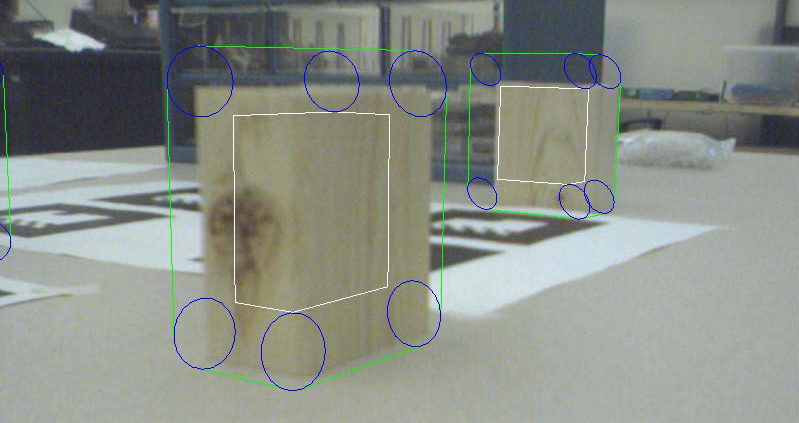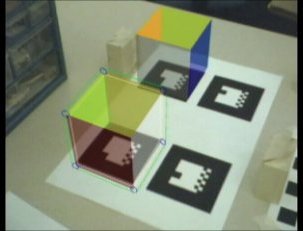 Registration errors between the physical world and computer-generated objects are a central problem in AR systems. In our previous work we demonstrated how to dynamically estimate registration errors based on estimates of spatial errors in the system. Using these errors estimates, we demonstrated a number of ways of ameliorating the effects of registration error. One central part of our work was the creation, and use, of error regions around objects; unfortunately, the analytic methods used only created accurate regions for simple convex objects. We present a simple algorithm for generating the uncertainty regions for complex objects, including non-convex objects and objects with interior holes. We demonstrate how our approach can be used to create a set of more accurate error-based highlights, and also used as a general highlighting mechanism.
Registration errors between the physical world and computer-generated objects are a central problem in AR systems. In our previous work we demonstrated how to dynamically estimate registration errors based on estimates of spatial errors in the system. Using these errors estimates, we demonstrated a number of ways of ameliorating the effects of registration error. One central part of our work was the creation, and use, of error regions around objects; unfortunately, the analytic methods used only created accurate regions for simple convex objects. We present a simple algorithm for generating the uncertainty regions for complex objects, including non-convex objects and objects with interior holes. We demonstrate how our approach can be used to create a set of more accurate error-based highlights, and also used as a general highlighting mechanism.
 OSGAR extends OpenSceneGraph so that it will be suitable to be used for AR applications, by supporting transformations that have uncertainty associated with them. Building on the fundamental notion of uncertain transformation, OSGAR provides programmers with a range of facilities for querying and acting upon estimated registration error. The following are a sample of the kinds capabilities we are adding to the scene graph:
OSGAR extends OpenSceneGraph so that it will be suitable to be used for AR applications, by supporting transformations that have uncertainty associated with them. Building on the fundamental notion of uncertain transformation, OSGAR provides programmers with a range of facilities for querying and acting upon estimated registration error. The following are a sample of the kinds capabilities we are adding to the scene graph:
- Display a video stream as a background (Video AR)
- Detect artificial markers
- Connect to different sensors through a VRPN client
- Handle multiple sensors (combiners)
- Computer registration error estimates in real time
This work is supported by ONR Contract N000140010361.

5 comments
1 ping
Skip to comment form
where can i get the osgar code or some apps
The code is pretty old at this point; what’s your use case? If you are just looking for an AR framework, there are many newer ones. Or are you specifically interested in some of OSGAR’s features?
This tool seems interesting.
OSGAR is really wonderful tools .
Very effective tools.
[…] ISMAR 2004, we will present a paper on the design of OSGAR (our AR software architecture that supports uncertain transformations). Integrating uncertain […]